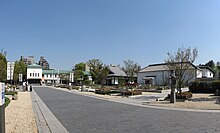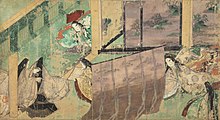Tokugawa Art Museum


The Tokugawa Art Museum (徳川美術館, Tokugawa Bijutsukan) is a private art museum, located on the former Ōzone Shimoyashiki compound in Nagoya, central Japan. Its collection contains more than 12,000 items, including swords, armor, Noh costumes and masks, lacquer furniture, Chinese and Japanese ceramics, calligraphy, and paintings from the Chinese Song and Yuan dynasties (960-1368).
History
Unlike many private museums in Japan, which are based on collections assembled in the modern era by corporations or entrepreneurs, the Tokugawa Art Museum houses the hereditary collection of the Owari branch of the Tokugawa clan, which ruled the Owari Domain in what is now Aichi Prefecture. The museum is operated by the Tokugawa Reimeikai Foundation, which was founded in 1931 by Yoshichika Tokugawa (1886–1976), 19th head of the Owari clan, in order to preserve the clan's priceless collection of art objects, furnishings, and heirlooms.
The main building of the museum was constructed in the 1930s in a classic Japanese style with western elements.
Collection

The permanent exhibition is housed in a historical reproduction of the living quarters of the Owari daimyō, allowing visitors to view the objects as they were actually used in settings such as a Japanese tea-house or Noh stage. The museum also mounts temporary exhibitions in a building that has been declared a national cultural property.
The most important and valuable treasures are three Heian period illustrated handscrolls of The Tale of Genji, dating to the 1130s. Along with one other scroll from the same set, now preserved at the Gotoh Museum, they are the earliest extant depictions of the epic tale and are National Treasures of Japan. The scrolls are so fragile that they are not permanently displayed to the public. Since at least 2001, they have been displayed in the Tokugawa Museum for one week in November.
The Hōsa Library is located next to the museum and houses 110,000 items including classic literature belonging to the Owari branch. Located next to the museum is the Tokugawa Garden.
See also
- Daimyo collection
- List of National Treasures of Japan (paintings)
- List of National Treasures of Japan (crafts-others)
- List of National Treasures of Japan (crafts-swords)
Literature
- The Tokugawa Art Museum. Nagoya: The Tokugawa Art Museum. 1988. ASIN B000VQ5F9O.
- The Shogun Age Exhibition From The Tokugawa Art Museum. Nagoya: Shogun Age Exhibition Committee. 1985. ASIN B000UDO9BS.
External links
![]() Media related to Tokugawa Art Museum at Wikimedia Commons
Media related to Tokugawa Art Museum at Wikimedia Commons
